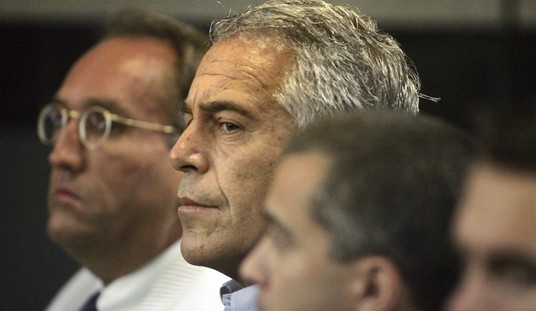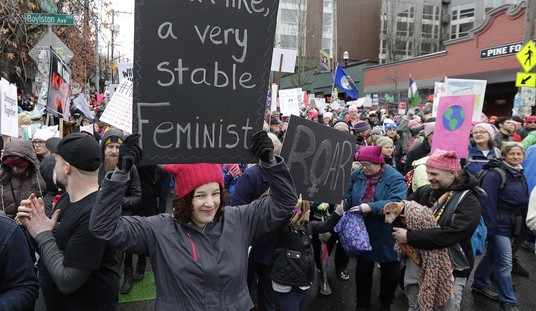
FILE – In this May 8, 2018, file photo, Mohamed Noor arrives at the Hennepin County Government Center for a hearing in Minneapolis. The former Minneapolis police officer who shot and killed an Australian woman last summer is charged with third-degree murder and second-degree manslaughter in the July 15, 2017 killing of Justine Ruszczyk Damond. Attorneys for Damond are working on a civil rights complaint and plan to file a lawsuit Monday, July 23, 2018, in federal court. (AP Photo/Jim Mone, File)
In a perfect world, Minneapolis police officer Mohamed Noor would never have been hired and Justine Damond Ruszczyk would be alive. But the world isn’t perfect and now Noor will serve 12½ years in prison, Ruszczyk is dead, and Minneapolis taxpayers are at least $20 million poorer.
Noor, a Somali immigrant, was recruited into the Minneapolis Police Department as part of a program designed to increase “diversity.” He went through a truncated training program and psychologists and fellow officers had lots of doubts about his suitability as a police officer.
In court documents filed this week, Hennepin County prosecutors argue that Noor’s own answers to questions in his pre-hire screening demonstrate that he was “unsuited for the job.”
After reviewing the court filing, former MPD officer Michael Quinn agreed.
“This man should have never made it through the field training program,” Quinn said.
Quinn ran the Minneapolis Police Training Academy during the 1990s. He said the incidents raise serious “red flags” about Noor’s ability to carry out the job.
Among them, prosecutors detail a minor traffic stop, writing in the court filing that Noor “pulled out his gun, carried it toward the car, and pointed it into the driver’s window at the driver’s head before uttering a word.”
Prosecutors also point to an evaluation completed by Noor’s field training officer, who wrote that “while police calls were pending, (Noor) drove around in circles, ignoring calls when he could have self-assigned to them.”
In his review, Quinn said Noor demonstrated a pattern of behavior that should have disqualified him from the job.
“To me, either one of those would have been the end of his employment,” Quinn said.
In addition to listing specific on the job incidents, prosecutors also bring in several details from Noor’s psych evaluation.
Prosecutors argue that Noor himself “reported disliking people and being around them,” and that he “self-reported disinterest in interacting with other people.”
The psych tests showed, according to court documents that Noor “is more likely to become impatient with others over minor infractions” and “is more likely to exhibit difficulties confronting subjects.”
Quinn said with those details, the department should not have forwarded Noor onto the field training program.
“We did everything we could to get those candidates through and look past small things,” Quinn said, recalling his time at the academy. “These are not small things in his case. These are things that when you look at what was written up in the psychological, these are things that are disqualifiers.”
But bureaucracies, much like living creatures, respond to positive and negative reinforcement. They move towards pleasure and away from pain. Pain here would have been firing one of the few Somalis to become a Minneapolis police officer and having to take the heated wokeness that would sure accompany it. So the path of least resistance was to push him through training, ignore the warning signs and the guidelines based on experience, and just hope nothing really bad happened over the next 20 or 30 years that he’d be on the force.
In didn’t turn out that way.
Roughly two months before the shooting, Noor put a gun to the head of a motorist pulled over for a minor traffic stop, according to the prosecution filing.
Noor stopped his squad on 24th Street west of Nicollet Avenue and got out “with his gun pulled and pointed downward,” the court document read, citing squad car video. “When the defendant approached the driver’s side of the stopped car, the first thing he did was point his gun at the driver’s head.”
Noor’s partner approached the stopped vehicle on the passenger side, also with his gun out of its holster but not pointing directly at the driver, the filing read.
An initial police incident report explained the reason for the stop: the officers saw the driver give the finger to a bicyclist and then pass a vehicle on the right without signaling.
Neither Noor nor his partner on that shift filed anything further or “documented their display of force or any justification for it,” the prosecution filing read. The driver was ticket for failing to signal, and the citation was dismissed after Noor failed to appear at a court hearing.
On the night of July 15, 2017, Justine Damond Ruszczyk, made two calls to 911. The first was at 11:27 p.m. followed by another at 11:35. She reported that she thought she heard a woman being assaulted or raped. Noor and his partner were dispatched to the scene. They arrived at the location by driving through an alley with their lights off. Noor reported to his dispatcher that the scene was safe. Damond Ruszczyk saw the police car an approached it on the driver’s side. Noor’s partner drew his weapon and kept it out of sight, Noor drew his weapon, leaned across his partner and fired a single shot striking Damond Ruszczyk in the abdomen, a wound that caused her to die on the scene.
The Blue Wall went up. Police officers refused to cooperate with the prosecutor. A search warrant looking for ‘bodily fluids, controlled substances, and writings’ was served on the residence of the victim. Body cameras were turned off. A story was concocted of something hitting the patrol vehicle and “fear of ambush.” Eventually a grand jury was impaneled and eventually Noor was indicted for third degree murder.
In April, Noor was convicted and last Friday he was sentenced.
Predictably, the narrative pushed was that Noor was only convicted because he was a Somali and an immigrant and he shot an attractive white woman.
They gave Mohamed Noor 12 years in prison.
But I thought it was all about “backing the blue”…
I thought these killings were always justified because “cops have to make split second decisions”, etc. What happen to the #BlueLivesMatter crowd? https://t.co/EwVnNLWbkb— Tariq Nasheed 🇺🇸 (@tariqnasheed) June 7, 2019
2 painful things are true.
1. Officer Mohamed Noor shot & killed an unarmed, non-violent woman. Cops should go to jail for this.
2. No cop has ever been convicted for what he did. They should have been. Unlike them he was Black, Muslim, an immigrant. And killed a white woman. https://t.co/QLwnIJ0IoO
— Shaun King (@shaunking) June 7, 2019
Mohamed Noor’s brother now speaking… says the former officer is a “scapegoat,” and that his brother was treated differently than other officers in Minneapolis. @KSTP pic.twitter.com/lhgTNj0pbl
— Kirsten Swanson (@KirstenKSTP) June 6, 2019
If the color of the skin reversed, no way this sentence is given.
Opinion: Mohamed Noor's conviction raises uncomfortable questions about racehttps://t.co/Rq9FtM68EL
— Theodore Henry (@tjhenry109) June 7, 2019
I wonder how Black police officers around the country feel about Mohamed Noor getting thrown under the bus? You Black Officer have to help maintain the “Blue Wall” (which is really the WHITE wall) to protect white murderers employed in LE.
Yet they do NOT offer the same for YOU
— Tariq Nasheed 🇺🇸 (@tariqnasheed) June 7, 2019
I have to break with these activists on this, actually.
Mohamed Noor should’ve been convicted for what he did. He shot and killed an unarmed non-violent woman.
We just also want white cops who kill Black people the exact same way to get the treatment that he received. https://t.co/QLwnIJ0IoO
— Shaun King (@shaunking) June 8, 2019
Most of this critique is utterly false. The MPD did try to cover for Noor. And while convicting officers of homicide in on-duty killings is very rare, when it does happen they receive sentences very much like Noor’s even though those trials take place in different jurisdictions.
Nationally, only three other police officers have been convicted of murder for an on-duty death, said Phil Stinson, a criminologist at Bowling Green State University in Ohio who’s tracked the data since 2005. The average sentence for those murder convictions is 12 1/2 years in prison — the same as Noor’s sentence on Friday.
The only times police officers who were convicted in an on-duty death have received no prison time were for manslaughter cases where the officer shot someone and the bullet ricochet killed someone else, according to Stinson.
Since 2005, 104 police officers were charged in on-duty killings nationwide. And of those, 36 have been convicted of a crime, Stinson added, so it’s a small sample of cases to begin. He said the sentences for those cases ranged from no incarceration on the low end to 40 years in prison on the high end.
Jason Van Dyke, who was convicted of murder for shooting Laquan McDonald in Chicago was sentenced to about seven years.
In Colorado, James Ashby received a 16-year sentence for killing Jack Jacquez after a confrontation in 2014.
Roy Oliver, of Texas, was the officer who shot 15-year-old Jordan Edwards as he rode in a car after a party. He was sentenced to 15 years.
Van Dyke and Oliver are both white and their victims black. Ashby is also white and his victim was a Latino. So, if there is any lesson to be drawn from this it seems to be that white-cop-minority-victim is most likely to draw trial and conviction.
The bottom line here is that Minneapolis wokeness was just as much to blame for this death and the long prison term Noor is facing as anything that happened that Saturday night two years ago. A flawed political process virtually mandated the hiring of marginal candidates from the correct communities to serve diversity. A flawed bureaucratic process was created to rush these candidates through training and ignore obvious red flags that would have gotten other probationary officers fired. The people who conceived of and promoted this policy should have been at the defendant’s table with Noor at sentencing and they should be keeping him warm tonight because Noor may have pulled the trigger, but those people put the gun in his hand and gave him a badge that let him think shooting people was just fine and dandy.
=========
=========
Like what you see? Then visit my story archive.
Follow @streiffredstate
I’m on Facebook. Drop by and join the fun there.
=========
=========














Join the conversation as a VIP Member